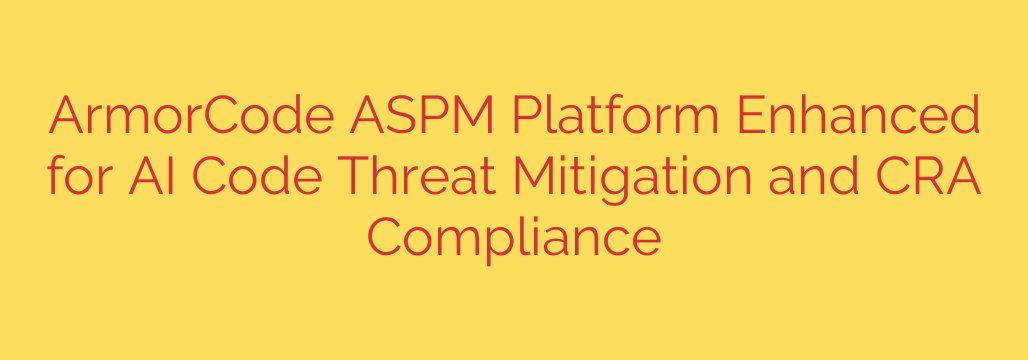
Securing the Future: How to Manage AI-Generated Code Risks and Meet New Compliance Demands
The rapid adoption of AI in software development is a game-changer. Tools like GitHub Copilot and ChatGPT are accelerating productivity, but this new frontier comes with significant, often hidden, security risks. As developers increasingly rely on AI to generate code, organizations face a new class of vulnerabilities that traditional security tools may miss.
This shift requires a more intelligent and unified approach to application security. It’s no longer enough to just scan for known issues; security teams must now understand the unique threats posed by AI-generated code and prepare for rising regulatory standards like the Cyber Resilience Act (CRA).
The Double-Edged Sword of AI in Coding
AI-powered coding assistants are incredibly effective at speeding up development cycles. They can suggest code snippets, complete functions, and even write entire modules in seconds. However, the models these tools are built on were trained on vast amounts of public code, including code that is outdated, insecure, or flawed.
This creates several critical challenges:
- Introduction of Hidden Vulnerabilities: AI can inadvertently generate code with subtle security flaws, such as SQL injection, cross-site scripting (XSS), or insecure direct object references.
- Use of Outdated Libraries: An AI model might recommend using a software library with known, unpatched vulnerabilities, instantly compromising your application.
- “AI Hallucinations”: Sometimes, AI models generate code that looks plausible but is functionally incorrect or insecure, creating bugs that are difficult to detect.
- Lack of Visibility: Without the right tools, it’s nearly impossible for security teams to know when and how developers are using AI, let alone if the generated code is safe.
The Rise of ASPM for Modern Threat Management
To combat these new challenges, forward-thinking organizations are turning to Application Security Posture Management (ASPM). ASPM is a centralized approach that provides a single, comprehensive view of security risks across the entire software development lifecycle.
Instead of relying on a dozen siloed tools, an ASPM platform integrates data from all your security scanners (SAST, DAST, SCA, etc.) to correlate findings, eliminate noise, and prioritize what truly matters. In the age of AI, a robust ASPM platform is essential for gaining control over AI-generated code risks.
Key capabilities needed to secure AI-assisted development include:
A Centralized AI Governance and Policy Engine: The first step is to set clear rules. Organizations must be able to define and enforce policies on which AI tools are approved for use and how they can be used. This ensures that all AI-generated code is automatically subject to security scanning and review, preventing it from becoming a blind spot.
Unified Visibility and Correlation: You can’t secure what you can’t see. An effective security strategy requires a platform that can ingest findings from every tool in your stack. By correlating data, you can identify which vulnerabilities pose the most significant threat, see if a flaw introduced by AI exists elsewhere, and drastically reduce false positives.
Intelligent Vulnerability Prioritization: Not all alerts are created equal. A critical vulnerability in a non-production, internal application is less urgent than a moderate one in your main payment processing API. Modern security platforms provide risk-based prioritization, factoring in business context and exploitability to help teams focus their limited resources on the most critical fixes first.
Meeting Regulatory Demands: The Cyber Resilience Act (CRA)
Beyond the immediate security threats, new regulations are raising the stakes for software producers. The European Union’s Cyber Resilience Act (CRA) is a landmark piece of legislation that will mandate stringent security requirements for any company selling software products in the EU.
The CRA demands greater transparency and accountability throughout the software supply chain. Two of its core components are the Software Bill of Materials (SBOM) and the Vulnerability Exploitability eXchange (VEX).
SBOM (Software Bill of Materials): This is a detailed inventory of every component, library, and dependency used to build an application. A comprehensive and accurate SBOM is no longer optional; it’s a foundational requirement for compliance and supply chain security. It provides the visibility needed to quickly identify if a newly discovered vulnerability affects your product.
VEX (Vulnerability Exploitability eXchange): A VEX document complements an SBOM by providing a status on whether a product is actually affected by a specific vulnerability in one of its components. This is crucial for communicating with customers and avoiding unnecessary panic and patching efforts. For example, your product might use a vulnerable library, but if the specific vulnerable function is never called, your VEX can state that you are not affected.
An ASPM platform is instrumental in meeting these CRA requirements by automating the generation of SBOMs and helping to manage the data needed for VEX documentation, ensuring you are prepared for this new era of regulatory scrutiny.
Actionable Steps for a More Secure Future
Navigating this new landscape requires a proactive and strategic approach. Here are key steps your organization can take today:
- Treat AI-Generated Code as Untrusted: Implement a “trust but verify” policy. All code, regardless of its origin, must pass through the same rigorous security scanning and review processes.
- Centralize Your Security Program: Move away from siloed tools and adopt an ASPM approach to gain a unified view of your true security posture.
- Automate Compliance Artifacts: Use modern tools to automatically generate and maintain SBOMs to ensure you are always ready for compliance audits and customer requests.
- Prioritize Ruthlessly: Focus remediation efforts on vulnerabilities that are confirmed to be exploitable and pose a genuine risk to your business operations.
The integration of AI into software development is not a passing trend—it’s the future. By embracing a modern, unified, and risk-based security strategy, organizations can harness the power of AI for innovation while protecting themselves, their customers, and their software supply chain from emerging threats.
Source: https://www.helpnetsecurity.com/2025/08/06/armorcode-agentic-ai-remediation-capabilities/








